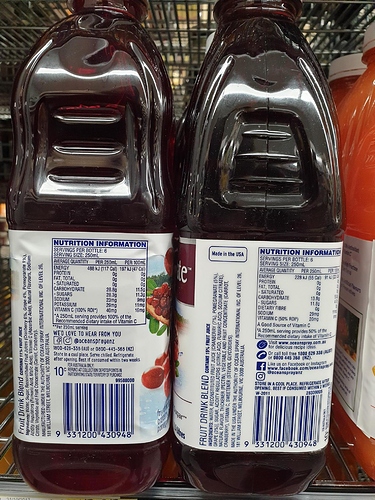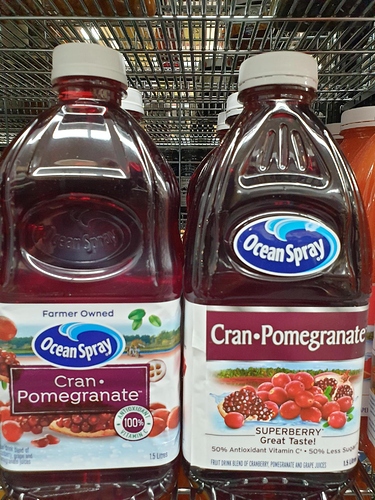Has anyone else been caught out by Ocean Spray’s new ‘recipe’ for its Cran-Pomegranate drink? I saw new packaging and thought nothing of it. Brands update packaging all the time. It wasn’t until we tasted it that we realised it was different inside as well (and not in a good way):
Original: Made in USA. Contains 15% fruit juice (cranberry 7%, pomegranate 5%, grape 3%). Sugars 11.8g/250ml.
New: Made in Australia (88% local ingredients). Contains 11% fruit juice (cranberry 6%, grape 4%, pomegranate 1%). Sugars 28.3g/250ml.
So, in order for this product to be majority made and sourced in Australia, it needs to have more than double the amount of sugar and less of the fruit it is named for - that’s so ridiculous!
I realise neither variety sits high on the healthy scale, but the original was a nice addition to a glass of cold water, and a less ‘sugary’ non-alcoholic option on social occasions. Disappointing.
Wow, same barcode too. Dodgy AF.
The label states that the company would love to hear from you on facebook and instagram. You might get some interesting answers if you take up their offer.
Gosh it was bad enough before! Thanks for letting us know.
Welcome to the community @LAB.
Well spotted.
The pomegranate content is now just 1% of the product. That’s less than the cranberry 6% and grape 4%.
Has the product naming changed from Cran-Pomeganate to Cran-Grape drink?
Looking at the producers web site - NO and a very dubious claim about the sugar content.
P.S.
‘Farmer Owned’ does not do it for me in this instance.
Who are the farmers?
Dis someone say China?
Their website certainly does not say anything about origin.
The new recipe seems to coincide with a change in manufacture. They go on at length about being a cooperative of 700 American farmers but that may have nothing to do with the ingredients of the product made here. It is an American company that hold the name and have licensed it to be made here. The stated problem is not with the origin of the fruit but changing the formula and using the same name. If the reformulation is sneaky and unacceptable it was approved by American management.
So why bring up China? You rarely let an opportunity pass to put the slipper in there, evidence or no. This is plain prejudice that does nothing for the consumer.
Still dodgy as, considering what may be gaming the system for Australian content.
Pomegranate production in Australia is minimal, and what there is appears to be high value product.
Cranberry production is also not significant.
In one possibly sponsored magazine article the same 700 American farmers advise cranberries CANNOT be GROWN commercially in Australia.
The following growers guide suggests otherwise.
More questions than answers?
Although not a problem if one chooses to not consume anything with American Cranberry content.
Thanks mark_m. Comparing the new to the old packaging, the 50% less sugar claim has mysteriously disappeared!
The 100% or 50% antioxidant & vitamin C motif has me puzzled.
It reminds me of the puffery on many expensive cosmetic products, except in this instance the Cran Pomegranate product is for human consumption.
There is an assumption too that ‘Cran Pomegranate’ is a product brand name, and as such does not need to describe the contents. Although it could be taken as misleading by some if the fine print is not inspected.
Not necessarily. Many brands, American and otherwise, license their names and stay at arms length. Others keep some sort of oversight to maintain brand integrity whether tightly or loosely. One does not know who approves what unless they have the license in hand. Some are the equivalent of franchises where the products, look and feel must be followed, and others just the name and logo, and it varies over time who does what to whom how.
You are right we don’t know who made the decision the local manufacturer or parent company. Neither appear to be Chinese.
Referring to the first image that was posted, a 250 ml serving provides 50% of the RDI for Vitamin C (old product) or 100% of the RDI for Vitamin C (new product).
I wouldn’t recommend an actual serving of “250 ml” - due to the high amount of sugar.
I wonder why the new label doesn’t include the brag “140% more sugar”.
Along the same lines, but not as drastic. I buy Cottee’s Lemon Crush cordial. It used to say 50% fruit juice. A while back the label changed to 40%. A comparison of ingredients indicated nothing had changed except the amount of water. Neither had the bar code or the price changed. Very sneaky. And not so good for the environment - 25% more plastic to landfill, 25% more weight being transported around.


